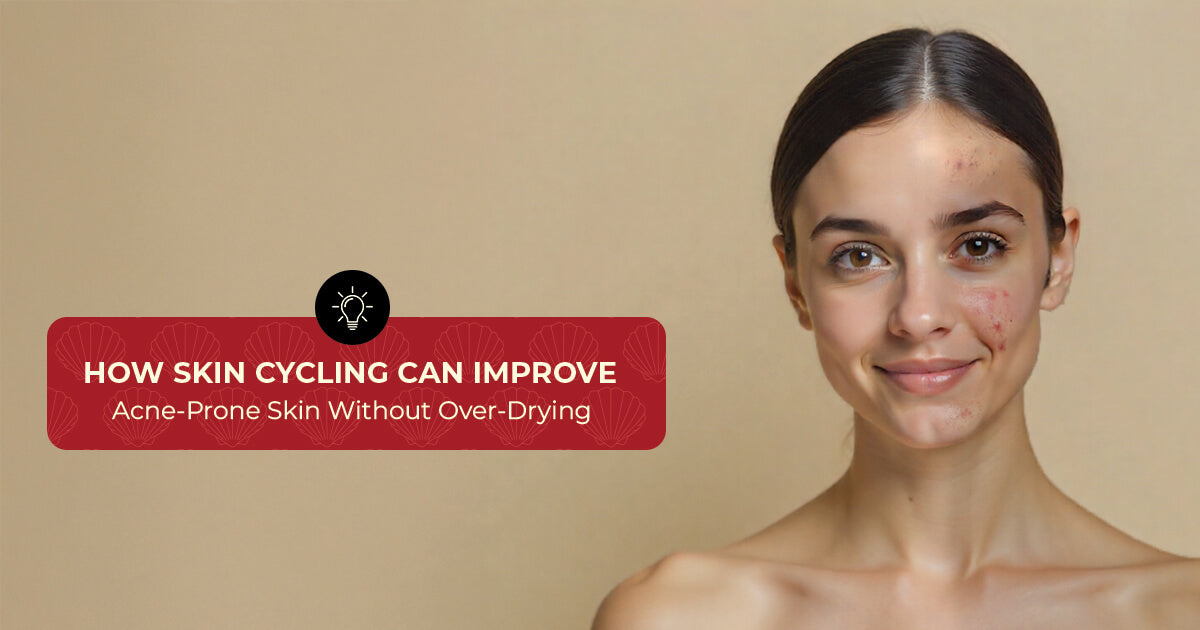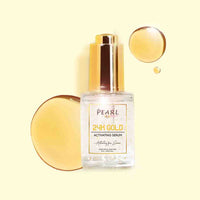Acne-prone skin? Tired of trying countless cleansers, serums and spot treatments? Skin dryness, irritation and worse breakouts? Here’s the new solution that balances between treating acne prone skin along with strengthening the skin barrier and making it healthy-That’s skin cycling. It’s a structured skincare routine with active ingredients rotating over several nights to effectively treat acne, and other skin conditions.
What Is Skin Cycling?
Skin Cycling follows a four-night skincare routine designed to balance active treatments like exfoliants and retinoids with recovery nights focused on hydration and barrier repair.

A typical skin cycling schedule looks like this:
Night 1 – Exfoliation: Exfoliation is done with AHAs or BHAs as they unclog the pores and remove impurities and dead skin cells.
Night 2 – Retinoid: The purpose of retinol is to boost the cell turnover and prevent clogged pores. Apply retinol on this day.
Nights 3 & 4 – Recovery: Avoid usage of harsh ingredients on this day. Apply nourishment to the skin like gentle moisturizer, hydrating serum and ceramide rich creams as it helps the skin recover.
Why Skin Cycling Works for Acne-Prone Skin
Targets Breakouts Without Overloading Your Skin
Applying too many active ingredients on the skin at a time damages the skin barrier. Following skin cycling ensures acne-fighting products like exfoliants and retinoids to be used in controlled manner which reduces the risk of skin irritation.
Prevents Over-Drying
Acne treatments often strip the skin’s natural oils where the skin tends to become dry and flaky. Alternating the products with recovery nights i.e., following skin cycling ensures your skin replenishes moisture and strengthen your skin barrier to protect from environmental stressors.
Reduces Redness and Sensitivity
When the skin is under recovery phase for acne-prone skin, it gets time to heal, soothe inflammation and rebuild resilience against harsh actives. This phase of skin cycling helps reduce redness and sensitivity.
Boosts Long-Term Results
Consistency is the key to achieving any goal. When dealing with acne, you must be consistent and skin cycling makes it easier to stick to the routine that’s effective yet gentle. It ensures long term results without any skin irritation.
The Best Ingredients to Use in Skin Cycling for Acne
Exfoliation Night: Use salicylic acid (BHA) or glycolic acid (AHA) as exfoliants which ease the process of unclogging the pores along with improving the skin texture.
Retinoid Night: Using retinol or adapalene the over-the-counter products to prevent clogged pores and work on reduction of acne marks over time.
Recovery Nights: Pick hydrating and repairing ingredients like hyaluronic acid, ceramides, niacinamide or aloe vera.
What Are The Tips for Acne-Prone Skin While Skin Cycling
Following are the tips for skin cycling for acne prone skin
Start Slow:
When your skin is new to retinoids, limit the exfoliation by using it once a week initially to check the skin builds tolerance.
Avoid Harsh Combinations:
Avoid application of exfoliants and retinoids on the same night as it causes skin irritation.

Moisturize Generously:
Oily skin and acne prone skin need hydration, so using lightweight, non-comedogenic moisturizer.
Use Sunscreen Daily:
Active treatments make your skin more sensitive to the sun, so SPF is non-negotiable.
Common Mistakes to Avoid
Over-Exfoliating: More exfoliations doesn’t mean faster results, as it damages your barrier and makes the acne worse.
Skipping Recovery Nights: These nights help the skin to relax and make it hydrated with moisturizer to prevent dryness and skin irritation.
Using Too Many New Products at Once: Introduce products slowly, one after another so that your skin gets adjusted and responds.
FAQs About Skin Cycling for Acne
1. Can skin cycling cure acne?
Not exactly as skin cycling helps to manage acne breakouts with minimal skin irritation.
2. How long will it take to see results with skin cycling?
Generally, following the skin cycling appropriately can give you results in 4-6 weeks. Improve your skin texture, reduce irritation with fewer breakouts.
3. Is skin cycling safe for sensitive acne-prone skin?
Yes, the main objective of skin cycling is for acne-prone skin to reduce skin irritation with low exfoliants and retinoids, prioritizing hydration on recovery nights.
4. Can I still use spot treatments while skin cycling?
Absolutely yes but ensure to apply the spot treatment specifically on breakout areas, avoid layering them with exfoliants and retinoids on the same night.
5. Do I need to follow the exact 4-night cycle?
Not necessarily. One can adjust the routine based on skin’s tolerance by adding more recovery nights when the skin feels dry and irritated.
Final Thoughts
Skin cycling is just not a beauty trend; it’s approved by the dermatologists to treat acne with gentler and sustainable processes. Altering between active treatment and recovery, these routine fights break out along with strengthening the skin barrier and hydrating it too! When you are tired of multiple products and routines that leaves your skin in confused state, skin cycling could balance the situation, making you feel better with balanced skin tone.










